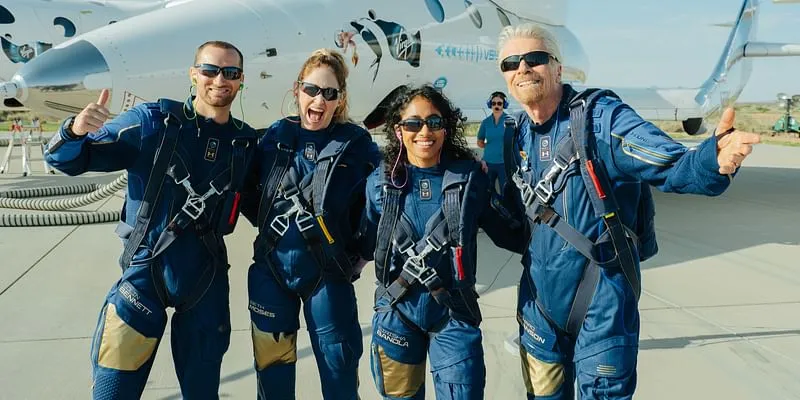Meet Sirisha Bandla, the third woman of Indian origin to fly into space
Sirisha Bandla shares, with HerStory, her journey of flying into space with Sir Richard Branson a year ago.
On July 11, 2021, Sirisha Bandla, then Astronaut Number 04, had an experience she can never forget. The sky was pitch black. But there was a blue planet shining bright in the voidness of space.
It's been a year, and yet there is only one word that Sirisha can think that best describes her experience in space - “Incredible.”
“You feel small but not insignificant. You come back to the earth feeling good and wanting to do so much more. I saw a boundary-less earth and planet. You realise how fragile the planet actually is. There are no state lines and borders. All the divides are created by us,” says Sirisha in a conversation with HerStory.

Sirisha in Space
It’s been a year since Sirisha, now Vice President, Government Affairs and Research Operations, Virgin Galactic, became the third Indian-origin woman to fly into space. She travelled with the founder of Virgin Group, Richard Branson, on the Virgin Galactic Unity 22 first fully-crewed successful suborbital test flight.
Today, Sirisha, an aeronautical engineer by qualification, is focused on helping others get to space. “Especially scientists. Now they can go directly to the field in space and test out the parameters. Otherwise, they would have to commission astronauts at the International Space Station or get NASA in. But with Virgin Galactic they can go there themselves,” says Sirisha.
Sirisha says the journey begins way before you go and continues much longer after the descent of the flight.
Her proverbial journey of a 1,000 steps began when she was five years old. One momentous night in her small village in Andhra Pradesh, where she was born, Sirisha had to sleep on the terrace of the house.
“There was a power outage, and I think we all wanted to escape the heat. Looking at the stars in the sky, I knew I wanted to be there one day. My mother told me for that I had to be an astronaut. And that is where my journey to space began,” says Sirisha.
Then she began reading all about space and indulging in science fiction and space fiction series and books. “I imagined myself being the captain of a spacecraft,” she says. Her end goal was space.

Unity -22 Team
“I had read all about the Apollo flights, and I knew that there were test pilots in the military. That was one option. The other option was follow the engineering route. I had followed the journey of Kalpana Chawla. And, while I had never met her, I knew she was an incredible engineer, and her journey is something I related with. That is how I got into aeronautical engineering,” says Sirisha.
Also, as she was interested in building things, mathematics, and sciences, engineering was the right path for her. However, while Sirisha had chalked out the path she wanted to follow, reality had other plans.
“When I was 15 years old, my eyesight got really bad. And when I was taking the prescription from my doctor, I knew instantly I was disqualified, since I had memorised the qualifications for a NASA astronaut. And my eyesight did not meet the criteria. I was devastated, and I felt I lost 15 years of my life,” says the aeronautical engineer.
But then, in 2004, her dreams took flight again. The Ansari X Prize was given to a private company that could build a spacecraft that could go into space and back twice. And SpaceShipOne won the prize.
Sirisha says, “Sir Richard Branson had announced he would start a company Virgin Galatic and open space for everyone. And I realised I can still go to space. I ended up pursuing commercial space. It taught me, and I would like to advise all—there isn't just one way of doing something. I hope my journey also inspires people to look at non-traditional ways of attaining their goal. You can use innovative methods. Today, commercial space is a real thing but several years back it was just a crazy idea. Never give up on a dream, find ways to achieve it.”
Edited by Swetha Kannan








